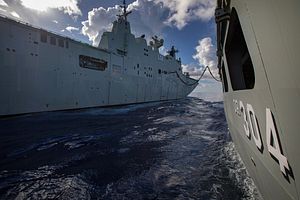The Royal Australian Navy’s (RANs) two largest warships, the Canberra-class landing helicopter docks (LHD) HMAS Canberra and HMAS Adelaide, have achieved final operational capability, the Australian Department of Defense (DoD) announced on November 12.
Australian Minister of Defense, Linda Reynolds, said in a statement that the two warships are ready to be deployed on amphibious operations such as humanitarian assistance and disaster relief, and amphibious warfare.
“The Australian Defense Force’s amphibious capability is an integral part of Australia’s strategic posture and this milestone is another step in Navy’s roadmap to delivering amphibious excellence,” Reynold noted.
HMAS Canberra was commissioned in November 2014, while HMAS Adelaide entered service in December 2015. Each Canberra-class LHD has a crew of 357.
The 27,500-tonne, 230 m-long amphibious assault ships can carry six helicopters—six-medium sized or four heavy lift rotorcraft–and four small LCM 1E landing craft that can accommodate the Australian Army’s M1A1 main battle tank.
Each ship can accommodate over 1,100 assault troops along with their equipment and around 110 vehicles. In addition, the Canberra-class can carry up to a million liters of aviation fuel.
The ships, when fully loaded, have a maximum range of 9,000 nautical miles (at an economic speed of 15 knots) and can achieve top speeds of 21 knots. The ships will form the core of the RANs planned new amphibious ready groups (ARGs).
“As we transition to a more technologically advanced navy, our goal is to be capable of conducting sustained combat operations as part of a joint force,” the head of the RAN, Vice Admiral Michael Noonan, said on November 12.
The Canberra-class is based on the design of the Spanish Navy’s light aircraft carrier Juan Carlos I.
Notably, the ships feature a ski-jump flight deck, which has raised speculations that the RAN may eventually upgrade the Canberra-class to operate the F-35B, capable of vertical or short takeoffs and vertical landings (STOVL) without requiring a catapult launcher.
The Australian government rejected the proposal as too costly. However, as Robert Farley points out, the debate over the warships’ conversion will likely continue:
The pro-F-35B case rests on several prongs. First, the Canberra-class can, with the appropriate modifications, operate the F-35B. This would give the RAN some capabilities that it has not possessed since the 1980s. Moreover, the F-35B is, because of its sensor and communications capabilities, uniquely appropriate for operating off light carriers such as the Canberra. Finally, with its ability to operate from small and unprepared airfields, the F-35B potentially offers more operational flexibility than its cousin [the F-35A].
(The Royal Australian Air Force (RAAF) is expected to receive a total of 72 F-35A Joint Strike Fighter aircraft with the entire F-35A fleet slated to reach full operating capability by 2023.)
The case against the F-35B rests principally on the arguments that a conversion would be technically complex and also dilute the Canberra’s LHDs amphibious warfare mission.
The two ships of the Canberra-class are home-ported at Garden Island, Sydney.
































